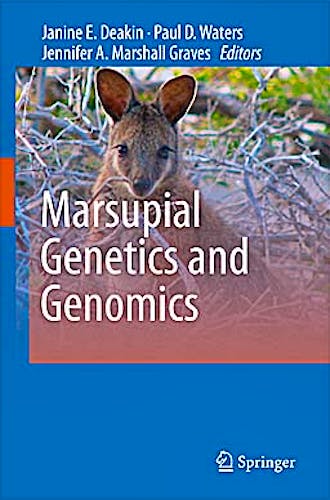

No hay productos en el carrito



Marsupial Genetics and Genomics
Deakin, J. — Marshall, J. — Waters, P.
1ª Edición Julio 2010
Inglés
Tapa dura
400 pags
1300 gr
16 x 24 x 3 cm
ISBN 9789048190225
Editorial SPRINGER
Marsupials belong to the Class Mammalia, sharing some features with other mammals, yet they also possess many unique features. It is their differences from the more traditionally studied mammals, such as mice and humans, that is of greatest value to comparative studies. Sequencing of genomes from two distantly related marsupials, the short grey-tailed opossum from South America and the Australian tammar wallaby, has launched marsupials into the genomics era and accelerated the rate of progress in marsupial research. With the current worldwide concern for the plight of the endangered Tasmanian devil, marsupial genetics and genomics research is even more important than ever if this species is to be saved from extinction. This volume recounts some of the history of research in this field and highlights the most recent advances in the many different areas of marsupial genetics and genomics research.
Content Level » Research
Related subjects » Animal Sciences
Table of contents
Preface.- Part I: Marsupial Breeding.- Introduction.- 1: Breeding and genetic
management of captive marsupial populations.- Part II: Marsupial Chromosomes
and Gene Maps.- Introduction.- 2: The conserved marsupial karyoptype; chromosome
painting and evolution.- 3: Marsupial centromeres and teloemeres: dynamic chromosome
domains.- 4: Marsupial linkage maps.- 5: Marsupial physical and comparative
maps.- Part III: Marsupial Genome Sequencing.- Introduction.- 6: Marsupial sequencing
projects and bioinformatics challenges.- 7: Insight into evolution of gene regulation
networks from the opossum genome.- Part IV: Marsupial Sex Chromosomes.- Introduction.-
8: Organization and Evolution of the Marsupial X Chromosome.- 9: Gene content
of the mammalian X chromosome.- 10: Marsupial sex chromosome behaviour during
male meiosis.- 11: Compact but complex – the marsupial Y.- Part V: Marsupial
Epigenetics.- Introduction.- 12: The evolution of genomic imprinting –
a marsupial perspective.- 13: Marsupial genetics reveals insights into evolution
of mammalian X chromosome inactivation.- Part VI: Marsupial Reproduction and
Developmental Genetics.- Introduction.- 14: Molecular regulation of marsupial
reproduction and development.- 15: Marsupial milk – identifying signals
for regulating mammary function and development of the young.- Part VII: Marsupial
Immune Genes.- Introduction.- 16: The marsupial major histocompatibility complex.-
17: Marsupial immunoglobulin and T cell receptor genomics.- 18: Use of genomics
information to gain insights into immune function in marsupials: a review of
divergent immune genes.- Part VIII: Marsupial Genes and Gene Evolution.- Introduction.-
19: Visual pigments and colour vision in marsupials and monotremes.- 20: The
evolutionary history of globin genes: insights from marsupials and monotremes.-
21: The olfactory receptor gene family of marsupials.- Part IX: Marsupial Conservation
Genetics.- Introduction.- 22: Marsupial population and conservation genetics.-
23: Devil Facial Tumour Disease (DFTD): Using genetics and genomics to investigate
infectious disease in an endangered marsupial.
© 2025 Axón Librería S.L.
2.149.0